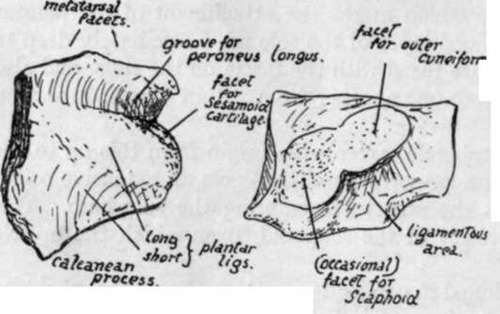Cuboid
Description
This section is from the book "The Anatomy Of The Human Skeleton", by J. Ernest Frazer. Also available from Amazon: The anatomy of the human skeleton.
Cuboid
This bone is really more pyramidal than cuboid in its general shape, for its dorsal, plantar, and anterior surfaces slope towards its narrow and short outer surface or border, with its broad base facing inwards and articulating with the outer cuneiform. The dorsal surface looks outwards and upwards, is roughened slightly by ligamentous fibres connecting it with the adjacent bones, and is covered by the tendons of Peroneus tertius and extensors for the outer toe. The plantar surface is marked by a deep groove, running obliquely across it immediately behind its front margin, for the tendon of Peroneus longus : behind this a thick ridge for the long plantar ligament, some fibres of which pass from the ridge over the groove to the metatarsus, and thus help to cover in the tendon. Behind the ridge is a hollow area for the attachment of the short plantar ligament. A facetted surface at the outer end of the ridge is for the play of the fibro-cartilaginous thickening in the tendon.
The posterior aspect has a concavo-convex articular surface for the os calcis, and the anterior surface has two continuous facets for the two outer metatarsals, the inner quadrilateral and the outer triangular. The outer surface or edge is notched for the peroneal tendon turning into the groove, is overlapped somewhat by the styloid process of the last metatarsal in front, and is covered by the muscular and ligamentous abductor of the outer toe.

Fig. 149.-Left cuboid, from below and from the inner side.
The inner side has a rounded facet for the outer cuneiform, often separated from the posterior surface by a non-articular area : in many bones, however, this area bears an articular facet for the scaphoid, and when this is present it connects the outer and posterior articular surfaces. The remainder of the inner surface is ligamentous, this being the area for outer attachment of the transverse fibres that hold up the transverse arch, connecting this bone, the scaphoid, and the cuneiforms.
The lower and inner angle of the bone is prolonged somewhat as a calcanean process : to this and the bone in the neighbourhood is attached the expansion from Tibialis posticus that passes below the head of astragalus. The short flexor of the great toe takes origin from this expansion and so from the bone here.
The cuboid is cartilaginous at birth, but there is very frequently an ossific centre present in it.
Continue to:
- prev: Os Calcis
- Table of Contents
- next: Scaphoid Or Navicular
